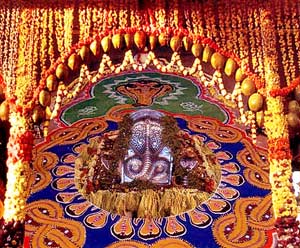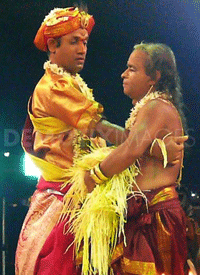|
|
| Nagaradhane | Nagamandala | Dakke-bali | Bhootaradhane | Bhootadakola |
|
Nagaradhane: From ancient times Bunts began worshipping Cobra (Naga). The cobra is a mixture of beauty and fear, which made them to bow down and worship it. |
|
|
At a later stage they must have started worshipping the cobra by installing cobra idols carved in stone, in the Nagabanas. The nagabanas are places where trees and vegetation was allowed to grow around the carved stone cobra structures. Today, we find each family has its own Nagabana, normally situated in the original house of that family. Nagabana is sometimes known as 'Moolasthaana'. Later,Brahmins settled in Tulunaadu and started performing poojas in the temples with Vedic mantras. Brahmins started worshipping Vedic gods like Shiva, Krishna, Janardhana, and Vishnu. So Bunts also adopted Brahmin modes of religious practices keeping "Nagaradhane" is their main form of worship. Due to this influence, some Nagabanas were converted into temples. Example: Kukke Subrahmanya. So Tulunadu was known as "NAGARAKHANDA" "Nagarpanchami" is the well-known festival of South Kanara. During this festival people offer milk to the nagabana. Even today important Boodu, Guthu, Baalike, Parari houses of Bunts community perform nagapooja in their respective nagabanas. | |
 |
It is a religious practice of Tulunadu. It's origin is still a mystery. It is a ritual which is more confined to four taluks - Udupi, Karkala, Mangalore, form.Puttur; it is performed in propitiation of Naga Serpent. The design of serpent is in "Panchavarna", meaning five colors (Black, White, Red, Green, and Yellow) in powder. |
|
Nagamandala (full) : If it is a full mandala there will be 16 knots to the serpent design. If 3/4th of Nagamandala the serpent design has 12 knots. If it is 1/2 Mandala the serpent design has 8 knots. Similarly for 1/4th of mandala - 4 knots. The design is decorated with flowers, especially with Areca flowers, which are considered to be very sacred for Naga. The design is properly decorated by different types of oil lamps. The dancers are Patri and Vaidya. Vaidya dressed in the form of Naga - Kannikas holds small drums called Dakke, there are two others dressed in ordinary clothes but who play music with Cymbals and drum beatings. All of them circle around the serpent design for 2 - 3 hours chanting musical ballads and the like. Finally a pooja is performed and "prasadam" is distributed. | |
 |
It is a religious practice part of Nagaraadane having unique distinction in Tulunadu. Its origin is unknown.The dance associated with dakke - Bali is confined only to "Vaidya" family. Vaidya families are extinct in South Kanara. The patri ( who gets the influence of naga) is a Brahmin. The vaidya is dressed in the form of nagakannika who holds the dakke and there are two others dressed in ordinary way who play music with cymbals and drum beating.All of them move to and fro in a circle around the serpent design for 2 to 3 hours chanting, playing music and the like. Finally, pooja is performed. It is less expensive compared to nagamandala. |
|
During ancient times itself Tulunadu people believed bhoota or spirit. In early times, Tuluvas believed that sun, moon, fire and air were supernatural powers. But they may have had a problem in believing and worshipping these forces because these objects are not physically present and also can not be sensed and felt. Hence they accepted them as witness. |
 | ||||
|
"I will see
that these rituals are followed as long as the sun and moon are there."
Natural stones of unusual shapes, huge trees, some times object like white-ant hills also became the object of their worship. They imagined them to have supernatural powers. Later when the Tuluvas stepped into the metal age,they were surprised to see the properties of metals. They kept such metals in religious places. Even today we can see a piece of iron at some of the oldest devotional places of ancient Tulunadu. So Tuluvas began worshipping any physical object which they could see, touch and feel but could not understand. Later as civilization developed white-ant hills, huts, roofs and temples replaced stones. Instead of wood,stones and metal-swords,statues came into existance. Jasmine, gold and silver are used for decoration of such places of worship along with areca nut and other wild flowers. So these customs are still deep routed in our culture. Gradually Tulava started worshiping strong and ferocious animals living in the jungles among them Cobra is the most important, Pilichandi (Tiger), Panjurli (wildboar), Maisandaaya ( wild buffalo), Nandikona (bull), Jattingha, Kodamanthaya. Even today these spirits are worshipped every where in Tulunadu. Next stage of religious practice by the Tuluvas was "soul worship". The curiosity to know how one is no more though their love and affection for their kith and kin continues,must have made him worship the departed soul. Even today every house performs this ritual, by offering food to the departed souls (Agel balasunu / Misaalu). Sometimes brave personalities or some one who has performed supernatural deeds are also worshiped as supernatural beings or spirits after their death. Slowly this spirit worshiping crossed family limits, reached the boundaries of village spread over entire Tulunadu. Kotichannya, Siri, Abbage - Daarage, Kalkuda - Kallurti, Kordhabbu, Bobbarya all these belongs to the category of spirits. Brahmins of Aryan origin settled in Tulunadu started worshipping Puranic personalities and powers. They started worshiping Kali, Raktheshwari, Chamundeshwari, Mahishasuramardhini, Durgi. Bhoota practices depend on its devotees and their social status. These Bhootas have different classes such as family bhoota, Rajya boota, Seema bhoota etc. Depending on their nature and area they were worshipped in different manner such as Agel, homa panchakajjaya, kola, kendaseve, nema, bandi, Aayana, Machchi, jaalata, olasiri, thambila etc. "Protection to the devotees and destruction of non-devotees" is the verdict always given by the Bhootas. So love, belief and worship of some power superior to us gives us the feeling of being protected by that power, which makes the life easier because of this mental balance.
The person who gets influence of bhoota speaks the ultimate truth (the hidden or invisible truth behind this visible object is the real truth ). The person who is a believer bows down to the darshanpaathri at the time of accepting "prasada" from him, this indicates he bows not to darshan paathri but to the ultimate truth behind that. | |||||